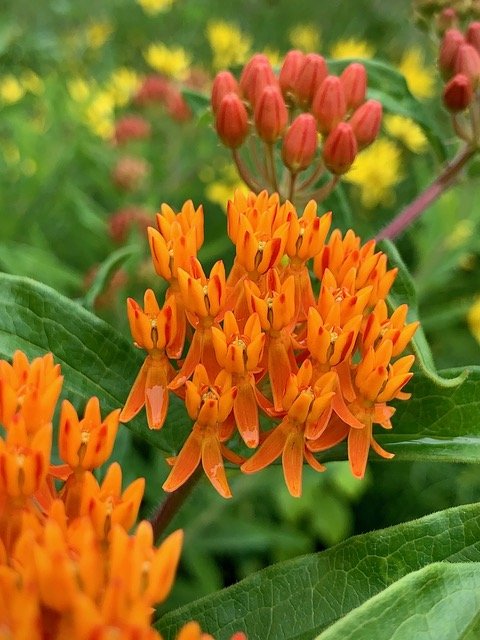Milkweeds
Asclepias syriaca (Common Milkweed), Asclepias tuberosa (Butterfly Weed), Asclepias incarnata (Swamp Milkweed)
Milkweed plants are the exclusive food of the caterpillars (larvae) of the Monarch butterfly. Only milkweed plants provide the essential nutritional profile that young Monarchs require.
In addition, as Monarch caterpillars consume milkweed leaves and flowers, they are also ingesting chemical compounds (cardiac glycosides) which do not harm them but make them horrible tasting (even toxic) to certain predators (birds, spiders, etc.). After one bite, most would-be predators (not all – that’s another story) quickly learn to leave monarchs alone.
Pic #1, Asclepias syriaca. Now flowering in most of our area are the near tennis ball-sized clusters of extremely fragrant flowers (overload for some folks!) of our Common Milkweed. This species is not clump-forming in its growth habit—its root system will wander about to form a loose colony of many stems—plan accordingly if planting into a highly controlled garden setting, and keep in mind it can take up to three years before they bloom and produce seeds.
Pic #2, Asclepias tuberosa. While totally lacking the fragrance of Common Milkweed, and differing in having a clumping growth habit, not a colony forming growth habit, Butterfly Weed or Butterfly Milkweed, has a color so intense one can’t help but notice them (glowing orange is most typical but red or very pale yellow also occur).
Sometimes called Railroad Annie for their tendency to grow along gritty, stony railroad embankments, this milkweed is completely at-home in sunny, hot, dry locations.
Pic #3, Asclepias incarnata. Following up on the previous two milkweed species is this one that loves “wet feet”, meaning a place where its roots reach into wet soils (edge of a pond, stream, or just growing in a low spot where water pools for a period of time after rain fall). Swamp Milkweed is also clump forming in growth habit. Its flowers have no appreciable fragrance to humans.
Adult Monarchs do sip nectar from milkweed flowers, but they also sip nectar from a wide array of other flower types – it is the young monarchs that have the requirement to feed exclusively on the softish parts of milkweed plants.
Milkweeds are also of great importance to a wide array of other “non-poster children” insect species, all of which have their own stories, such as the Red Milkweed Beetles (seen here).
Courtesy of Mark Gormel
Senior Manager of Horticulture
Brandywine Conservancy & Museum of Art (Chadds Ford, Pennsylvania)




